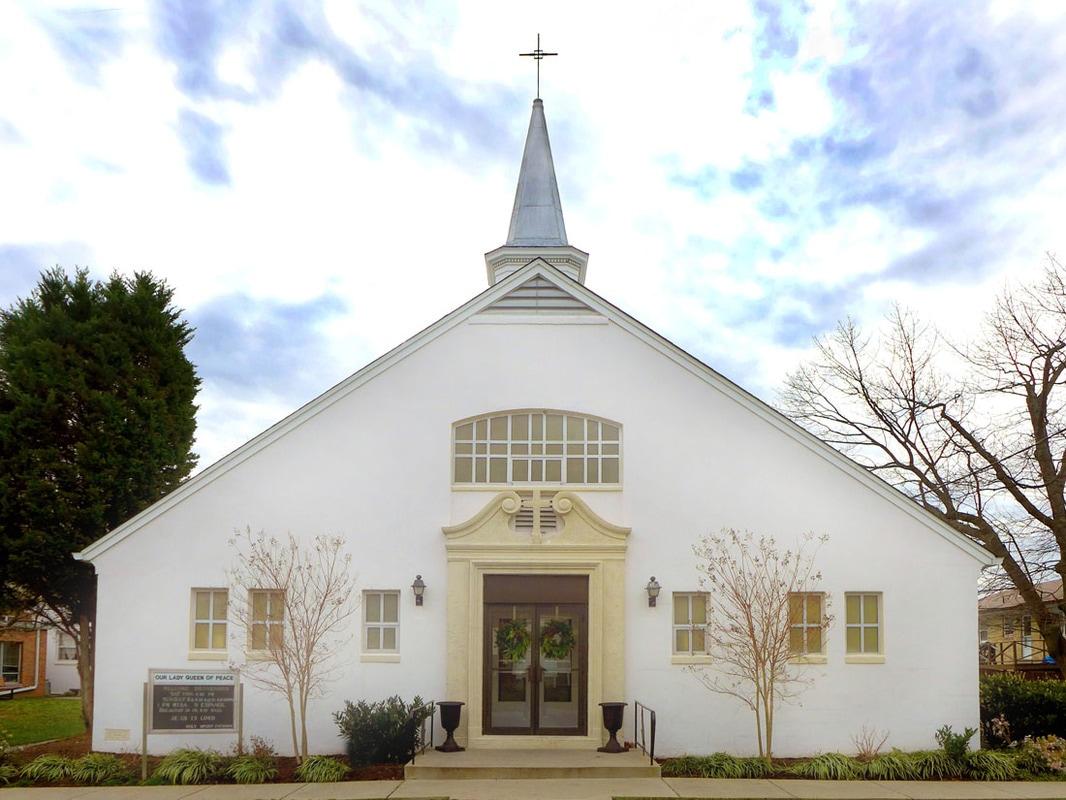Our Lady, Queen of Peace Roman Catholic Church
A group of dedicated individuals, many of whom resided in the predominantly Black Nauck and Green Valley neighborhoods, established a unique parish.
The history of Our Lady Queen of Peace (OLQP) reflects the culmination of the courageous efforts of a small group of Black Catholics in Arlington, who took Jesus at His word and laid the foundation for a worshipping community that welcomes all as members of the family of God. OLQP is a reminder of the barriers and challenges presented by lingering “Jim Crow” beliefs, racial prejudices, and segregation in Arlington in the period during and following World War II.
In 1945, Bishop Peter Ireton of the Diocese of Richmond granted the request of sixteen Black Catholics to establish their own church in Arlington County where they could worship in dignity. They were Joseph Bowman, Clarence and Selena Brown, Alice Butler, Lawrence and Jessie Butler, Irma Carter, Hattie Ellis, Mary Fernandes, Edward Marshall, Grace McGwinn, Edward and Alice Moorman, Constance Spencer, Sophia Terry, and Thaddenia West.
A group of dedicated individuals, many of whom resided in the predominantly Black Nauck and Green Valley neighborhoods, established a unique parish. They donated or acquired land along the end of S. 19th St. and developed plans for a new church. Throughout construction, materials and labor were generously donated to bring their vision to life.
On September 20, 1946, a groundbreaking ceremony was held to construct the new church. On Pentecost Sunday, June 15, 1947, Bishop Ireton dedicated Our Lady Queen of Peace Church as a parish for people of every background, but with particular emphasis on serving Arlington’s African-American Catholic community. Since the beginning, Holy Ghost Fathers of the Spiritan community have served the OLQP parishioners as pastors, including Fr. Hackett, Fr. Kanda, Fr. Jones, Fr. White, Fr. Ray, Fr. Healy, Fr. Duaime, Fr. Tuozzolo, and Fr. Hickey.
The church's commitment to social justice and racial equality has been its hallmark. The dedication of parishioners is embedded in Matthew 25:35: “I was hungry, and you fed me, thirsty, and you gave me drink; a stranger, and you welcomed me.” OLQP embraced the concept of helping others less fortunate.
Established when racial segregation prevailed in the broader society and the Catholic Church, OLQP became both a spiritual haven and a social community for its Black parishioners and the Arlington community. For example, in the 1960s, OLQP established the Catholic Interracial Council of Northern Virginia to work on poverty, employment, and fair housing issues. Since the 1970s, the Matthew 25 Bazaar, a clothing and thrift store, has provided weekly free services to people in need. OLQP also initiated a ministry for people experiencing homelessness, which was the first Arlington County homeless shelter for men housed in the rectory basement. It became the model for local governments to rely on church-based resources to respond to the increasing needs of people experiencing homelessness.
During the 1970s, new parishioners from Central and South America enriched the diversity of the OLQP parish. Since 1972, as Spanish-speaking individuals and families became an integral part of OLQP, a Sunday Mass as a Spanish liturgy has been celebrated. The rich mosaic of the Hispanic culture is celebrated through annual bilingual masses, during the parish picnic, and on other special occasions. Under the leadership of Fr. Joseph Nangle, OFM, the OLQP Hispanic community has expanded tremendously.
OLQP continued to foster its tradition of welcome, social justice, and community service during the final two decades of the twentieth century and into the millennium under the leadership of Frs. James Healy and Jeffrey Duaime, CSSp. OLQP ministries addressing local and international social justice and community service issues have been established and expanded.
A Queen of Peace Refugee Office established in 1986 served those in Salvadoran and Latin American communities facing fundamental social problems confronting them in Northern Virginia. Under the Haiti Ministry (founded by the author and two other parishioners in 1997), OLQP developed a twinning relationship with St. Joseph Parish in the remote rural village of Medor, Haiti.
Since then, over $2M in funds have been donated by parishioners to build a granary, undertake an extensive water purification project, and construct homes, a clinic, a new church, and a large new school. In addition, the ministry has provided extensive health-related services to the children and adults who live within a 25-mile radius of Medor, a population of about 30,000.
Over the years, numerous OLQP parishioners have traveled to Medor to provide a wide range of direct support and services. In 2002, a delegation of OLQP teens (co-led by the author) participated in a waste management and water purification project for Medor residents.
These are just a few examples of the many ministries for which OLQP is known—ministries that meet various needs related to social justice, spiritual development, liturgy and worship, and community building.
Our Lady Queen of Peace is a unique and visible example of Arlington’s successful battle with racial discrimination and segregation. Since its founding in 1945, it has established and promoted human values of equity, diversion, and inclusion.


